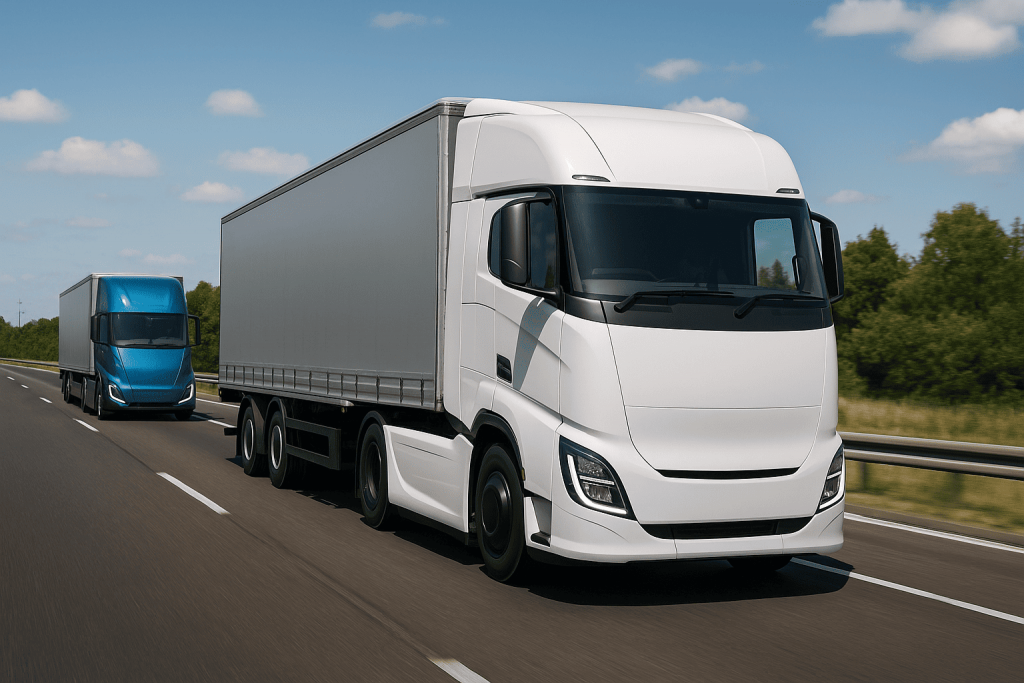The global push to decarbonize transport is no longer limited to passenger cars—heavy-duty trucks are now accelerating toward an electric future. In Europe, ambitious climate targets and zero-emission zones are driving rapid adoption of battery-electric trucks, while in Russia vast logistics corridors are beginning to see their first high-capacity e-rigs. This article explores the technological breakthroughs, infrastructure projects, and market forces propelling electric heavy transport across two very different geographies.
The Technology: Bigger Batteries, Faster Charging, Smarter Powertrains
Modern electric trucks rely on high-energy-density lithium-ion or emerging lithium-iron-phosphate (LFP) battery packs ranging from 300 kWh for regional delivery to more than 900 kWh for long-haul applications. OEMs like Volvo Trucks (FH Electric), Mercedes-Benz (eActros 600), Scania (45 R/S Electric), and Tesla (Semi) use modular battery architecture and 800- to 1,000-V systems to enable megawatt-level fast charging. Regenerative braking on long descents recoups significant energy, especially useful in mountainous European routes and the Urals.
Megawatt Charging System (MCS): The Upcoming Game Changer
The Megawatt Charging System—developed by CharIN—delivers up to 3.75 MW at 1,250 V / 3,000 A, slashing charging times to 30–45 minutes for a 600 kWh pack. Pilot corridors are live in Germany (HoLa project) and the Netherlands. By 2025, MCS stations are expected along the Rhine-Alpine corridor and Scandinavia, enabling true cross-border electric freight.
Europe: Policy-Driven Momentum
The EU’s “Fit for 55” package mandates a 45 % CO₂ reduction for new heavy-duty vehicles by 2030 and zero emissions by 2040. Germany, France, and the Nordics offer purchase subsidies up to €150,000 per truck, weight allowances (+2 t) to compensate for batteries, and toll exemptions. Urban bans on diesel trucks in cities such as Amsterdam, Paris, and Milan further accelerate fleet electrification. Retail giants like IKEA and DHL commit to 100 % zero-emission last-mile deliveries by 2030, driving demand for regional e-trucks.
Russia: The Long-Distance Challenge
Russia’s massive geography presents different hurdles—extreme cold, sparse charging networks, and multi-day hauls. Yet progress is evident:
• KAMAZ E-Companion—a 100-t BEV prototype with 800 km range, equipped with liquid-thermal pre-conditioning to withstand –40 °C.
• EVOCARGO Evo 1—an autonomous electric 3.5-t pod already servicing warehouses in Moscow Oblast.
• Federal Infrastructure Plans propose 500 kW fast chargers every 150 km on the M-11 “Neva” highway by 2026 and M-4 “Don” by 2028, co-funded by Rosseti and private investors.
Tax incentives (zero import duty on e-trucks until 2030) and preferential leasing via state program “Clean Transport” lower upfront costs for Russian logistics firms.
Total Cost of Ownership (TCO): Crossing the Break-Even Point
Battery prices fell below $120 / kWh in 2023, and European electricity prices for commercial users average €0.12 / kWh versus diesel at €1.50 / L. With maintenance costs 40 % lower (no oil, fewer moving parts) and road toll exemptions, analysts predict TCO parity with diesel for 40-t trucks by 2027 in the EU and 2029 in Russia’s western regions.
Grid Impact and Renewable Integration
Fleet depots increasingly install on-site solar and stationary storage (second-life truck batteries) to shave peak demand and provide vehicle-to-grid (V2G) services. In the Port of Rotterdam, a 30 MW solar canopy powers 80 e-trucks, selling excess energy back to the Dutch grid.
Cold-Weather Performance
In Scandinavia and Siberia, heat-pump HVAC, battery insulation, and active coolant loops reduce winter range loss to under 15 %. Pre-conditioning during charging keeps packs within optimal temperature bands, while low-viscosity lubricants minimize drivetrain drag.
Road Ahead: Autonomous and Platooned E-Freight
Autonomous modules like Einride’s Pods and Daimler’s eCascadia-based Freightliner with Level 4 capability are undergoing trials on restricted freight lanes. Platooning—wirelessly linking multiple e-trucks to reduce aerodynamic drag—targets an extra 10 % energy saving. EU legislation for cross-border platoons is expected by 2026; Russia’s pilot on the M-11 corridor aims for 2027.
Conclusion
Electric heavy-duty transport is shifting from pilot projects to mainstream adoption. In Europe, strict emissions laws, dense charging corridors, and corporate sustainability targets are driving rapid market growth. In Russia, state incentives, expanding fast-charge highways, and domestic OEM innovation are laying the groundwork for electrifying vast logistics routes. As battery technology matures, megawatt charging scales, and autonomous platoons emerge, electric trucks are poised to dominate both Europe’s busy motorways and Russia’s far-reaching freight networks—delivering cleaner, quieter, and more economical heavy transport for the decades ahead.



lol e-trucks rly ready? meh the last centyry👎👎
lol e-trucks r takin over EU & Russia👍
ev trucks takin over😁